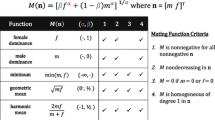Abstract
Long-term co-evolution of male's sexual extravagance and female's preference for it is studied. Fisher's ``Sexy Son'' principle is checked against Zahavi's Handicap Principle. It is shown that although both principles are equally likely to explain this sort of co-evolution in the short run, only the second one allows for a long-term evolutionarily stable females' preference for costly male's extravagance. It is shown, however, that Fisher's argument, although not sufficient on its own to explain long-term persistence of females' choice, may tacitly appear as an indispensable component for the application of Zahavi's theory to the important case of dense polygenous populations.
Similar content being viewed by others
Author information
Authors and Affiliations
Additional information
Received: 7 March 2001 / Revised version: 15 November 2001 / Published online: 26 June 2002
Rights and permissions
About this article
Cite this article
Eshel, I., Sansone, E. & Jacobs, F. A long-term genetic model for the evolution of sexual preference: the theories of Fisher and Zahavi re-examined. J Math Biol 45, 1–21 (2002). https://doi.org/10.1007/s002850200138
Issue Date:
DOI: https://doi.org/10.1007/s002850200138




